
ISSN: 2321 9653; IC Value: 45.98; SJ Impact Factor: 7.538 Volume 10 Issue XI Nov 2022 Available at www.ijraset.com


ISSN: 2321 9653; IC Value: 45.98; SJ Impact Factor: 7.538 Volume 10 Issue XI Nov 2022 Available at www.ijraset.com

1
Rajesh Mayya , Shalu Chopra
2
3
, M Vijayalakshmi 1, 2, 3Department of Information Technology VESIT MumbaiAbstract: The occurrence of Deep Learning models has substantially reformed the field of intelligent systems inheriting the likewise human behavior. These systems use Deep Neural Networks architecture, that is, to be effective in applying analytical and logical thinking to solve in all applicable fields. Deep Learning has pushed us to the limits in the domain of Digital Image Processing which had been in progressive development these years. Malaria is now a lethal, life threatening disease by Anopheles mosquito bite spread through Plasmodium parasites. This process needs trained experts or qualified technicians, to examine the spread-out blood smears under the microscope. In this paper, we put forward a comparative study of deep Learning techniques for malaria detection. We first classify the cell images. We apply convolutional neural networks (CNNs) to distinguish the cells. Then, we analyze the models using a pre trained learning approach, where the classification of infected cells improves diagnostic accuracy. This study uses Inception V3, NasNetMobile, MobileNetV2, Xception, and VGG 19 models for analysis. Many Deep learning algorithms can be used to predict malaria, but in this study, MobileNetv2 and Inception-V3 models have better accuracy.
Keywords: CNN, VGG 19, Xception, InceptionV3, MobileNetV2. Malaria
Malaria is a tropical severe disease, which spread to people through the infected Anopheles mosquito bite. It is one of the most contagious conditions in the world. The World Health Organization (WHO) data on malaria says that these parasites are responsible for over 200 million malaria cases every year and in which more than 400,000 deaths globally every year. The spread of plasmodium parasites which travel to liver, infect the haematids and develops severe traits. The most favored technique for diagnosis of Malaria plasmodium is examining under microscope slides of blood smear. The standard microscopy method involves the most typical visualization method of screening infected malaria cells. Malaria parasites identified under a microscope are conducted by applying a droplet of blood on a glass slide and are stained in a solution to give a distinctive cell appearance. Malaria is detected mainly through the first step of Thick blood smears, next examine the thin smear to identify the count of the patient's haematids infected with the parasite. To its simplicity, relatively lower cost, and the possibility of the definitive magnitude of the parasites in a droplet sample, this method of diagnosis of malaria is mainly used in laboratories. These acknowledged methods have led to pressing for improvements in microscopy. Therefore, this study proposes the use of automated techniques to identify malaria parasites in smear images of blood. Automation also rules out the human error of unseen parasites in a sample or fatigues due to repeated viewing of slides of samples. These advanced computer vision approaches would help to surpass the human ability to detect parasites to improve public health. These advancements will benefit the laboratory helping achieve consistency in the diagnosis of malaria. Deep learning methods are progressed strongly over the years and it's been the most successful in the classification of images in healthcare. These approaches have eased the feature extraction process and are proven to be much finer than the traditional style method. From here, the paper uses deep learning methods and put forward an advent use of a Convolutional neural network (CNN) for the detection of malaria from microscopic smear cell images. These methods have automatic feature selection by choosing relevant features. This paper, we review our Model selection and weigh them based on metrics and select the better of these models
1) Sai Bharadwaj Reddy and D. Sujitha Juliet [6], used the transfer learning model ResNet50 for malaria RBC cell image classification without use of GPU’s or an TPU’s. They achieved an accuracy of 95.91% that took several hours of training. They added a Fully Connected Dense layer and sigmoid activation function in last layers.
2) Subrata Sarkar, Rati Sharma, and Kushal Shah [5], presented a shallow CNN architecture that gave the same accuracy as of VGG 19 and ResNet 50 Models. These Models detected malaria where thin blood smear RBC images were given as input. There architecture had a significantly lower computation complexity lowering computating time.
ISSN: 2321 9653; IC Value: 45.98; SJ Impact Factor: 7.538 Volume 10 Issue XI Nov 2022 Available at www.ijraset.com

3) Akansha Singh, Neetika Porwal, Aditya Kumar [4], presented an automated CNN model for the detection of malaria cell images. They have deployed a miniature model in a server backed web application. They have got an accuracy of 96.52% from fine tuned model. They used Softmax layer in last layer removing the past trained networks last layer in fine tuned CNN model.
4) Rohan A Kamble, Srikanth E, Sumanth S Sajjan, Thushin Shetty, Dr. Soumya Patil [3], showing three models concepts a basic CNN model, Vgg19 with frozen CNN model and fine CNN tuned model to automatically predict cells of malaria in RBC images.
5) Amogh Manoj Joshi, Ananta Kumar Das, Subhasish Dhal [2] presented CNN model executed using a 5 fold cross validation approach, outperforming heavy CNN models. K fold, where K represented the number of folds the dataset is divided into. These model giving 99% accuracy.

The suggested model represents outline of the workflow. We obtain the dataset. The dataset is preprocessed where images are rotated, rescaled and flipped. Using Keras and Tensorflow library the, pre trained models are downloaded and trained based on existing weights defined for a similar kind of problems and evaluated for the classifying the images. CNN models layer are added through these libraries and trained from beginning and evaluated based on their performances. These Models are evaluated based on their performances.
We have acquired the Malaria dataset from official NIH Gov for this study. The total images were of 148 infected patients and 45 uninfected patients. The total images contained of 27558 images of malaria cells For this study purpose, we have taken 50000 images containing both infected falciparum cells and non infected malaria cells by duplicating the dataset The dataset was split to contain 40000 images for training and 10000 images to the testing dataset.


Deep structured learning is a technique i.e., based on the neural nets it can simulate a function that uses to make alike functions by the creation of patterns and purification data of the brain. The use of hidden layers has surpassed traditional techniques, helping in finding patterns. Convolutional Neural Network (CNN) types are generally used in neural networks that evaluate data either images or signals of different types. These ConvNet reduces these images by learning directly and convert into a form with important features eliminating the manual drawing of features for getting classified. The layers consist of convolution feature extraction layers, pooling dimension reduction layers, and fully connected classification layers.
ISSN: 2321 9653; IC Value: 45.98; SJ Impact Factor: 7.538 Volume 10 Issue XI Nov 2022 Available at www.ijraset.com

We used a basic Convolution Network with three convolutional layers of automatic feature drawing and three Max Pool layers. A normalization layer added joining the neural network layers. Batch Norm is a normalization technique to settle learning quickly as a process and helps decrease training epochs. A flattened Layer with two Dense Layers is used in the last Layers for detecting images. The activation function Relu was used between layers and other activation function sigmoid in the last layer for classification purposes. The change ratio in predicted with true class is the binary cross entropy. The model got trained having batch size of 64 and with 25 epochs.

In our daily routine, we unknowingly altogether transfer the knowledge of some activity or task to the related one. Whenever a new problem statement or task is identified, firstly we recognize it and try to apply the corresponding experience which results in hassle free completion of the task.
Machine learning method known as Transfer learning where the model built for a work/business is reused again for its task. Transfer learning has already resulted on top of training on 1000 image huge datasets which have particularly solved a problem. Transfer learning, thus an improved ability to learn a new task from a related task that had already learned through the transfer of knowledge. This adaptable technique allows us to use pre trained models in it as feature extraction with not training the whole model again and entirely integrated to the new models.
This research involves five CNN models that are popular in image classification using computer vision. They include VGG 19, Xception, MobileNetV2, NasNetMobile and Inception V3 which are more efficient in parameters such as loss function, activation function, batch size and learning rate. The uses of data generators for training and testing datasets of images for generating images with shearing, zooming, flipping, and rotation. Then we imported pre trained models as base models which are trained on thousands of images on ImageNet dataset. The base model is the added with a GlobalAveragePooling layer with three dense layers and a dropout layer. The Dropout layer is set to 20% to prevent overfitting. The Final dense layer has an activation function of the softmax layer for classifying output. An optimizer for updating weights using Adam optimizer and loss function to get the performance of our model using the categorical loss function. These models were trained with batch size of 64 for 25 epochs of training on the dataset.
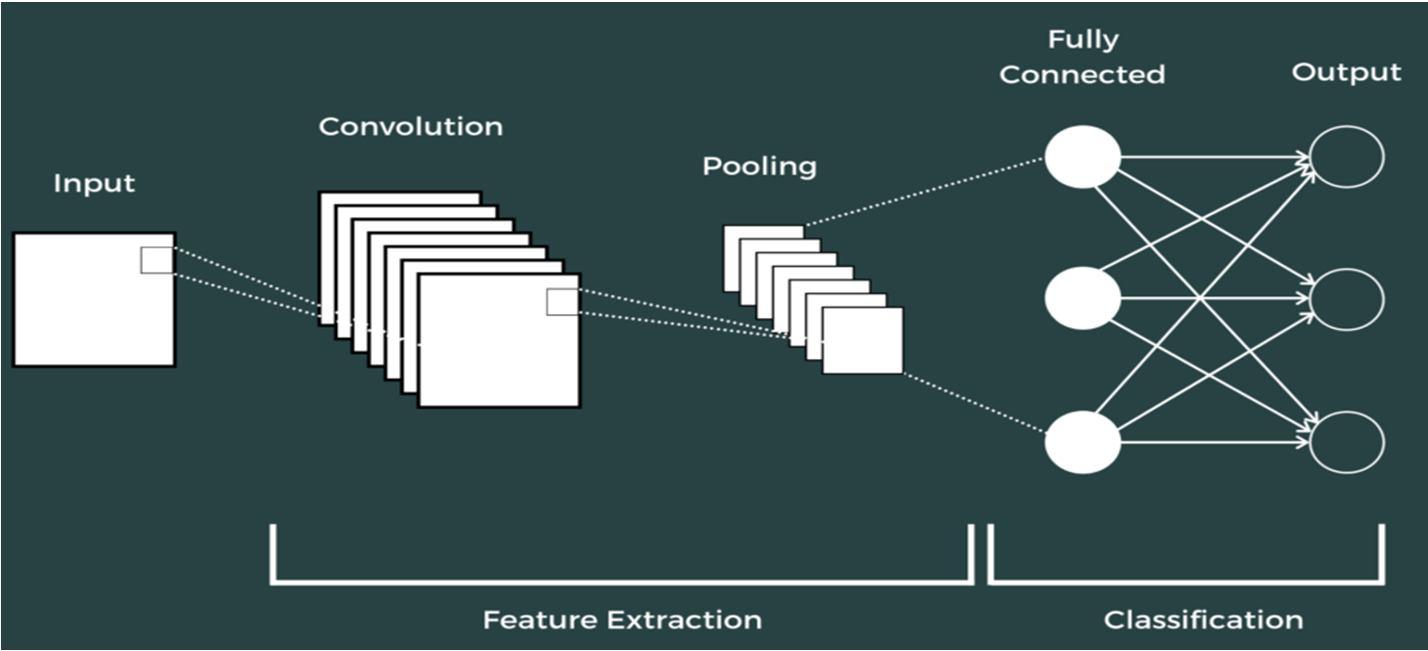
Fig. 5 Block Diagram of Transfer Learning Model
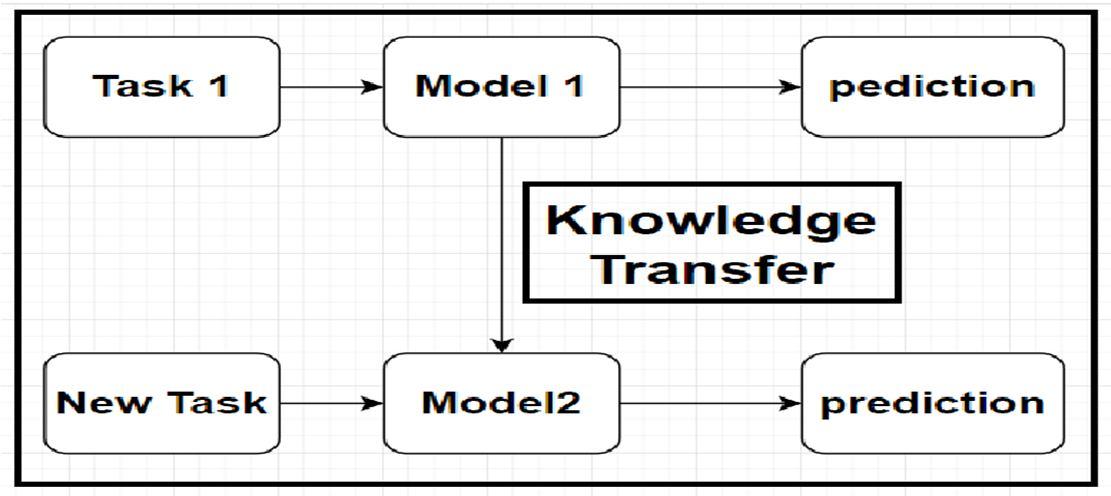
ISSN: 2321 9653; IC Value: 45.98; SJ Impact Factor: 7.538 Volume 10 Issue XI Nov 2022 Available at www.ijraset.com

The objective of work is to have an efficient model that predicts malaria cell images containing parasite present in images. After model building and training for malaria disease detection, the CNN model with 3 layers of convolutional layer gave an accuracy of 95.21%. The Validation of data gave an accuracy of 95.09%. The transfer learning models also got good results. The MobileNetV2 model training accuracy got 96.61% and a validation accuracy of 96.6%. Finally, the inceptionv3 model got an accuracy of 96.1% and a validation accuracy of 95.99%. Both these models got the highest accuracy in these transfer learning models. An image prediction by the model is shown below.
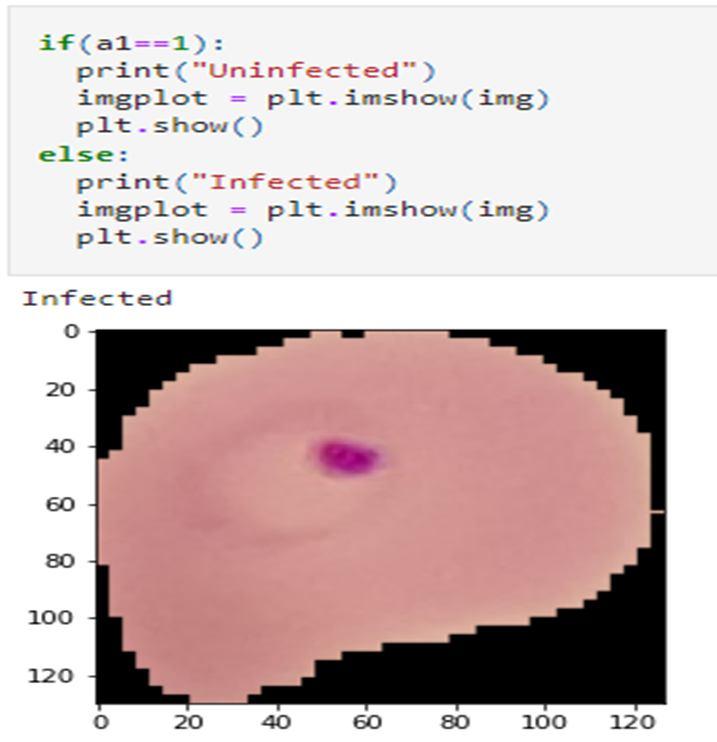

I. TABLE I ACCURACY OF ALL MODELS Models Training Accuracy Validation Accuracy CNN 0.9521 0.9509 Xception 0.9571 0.9115 MobileNetV2 0.9661 0.9660 InceptionV3 0.9610 0.9599 NasNetMobile 0.9526 0.9477 VGG19 0.9498 0.9477

ISSN: 2321 9653; IC Value: 45.98; SJ Impact Factor: 7.538 Volume 10 Issue XI Nov 2022 Available at www.ijraset.com



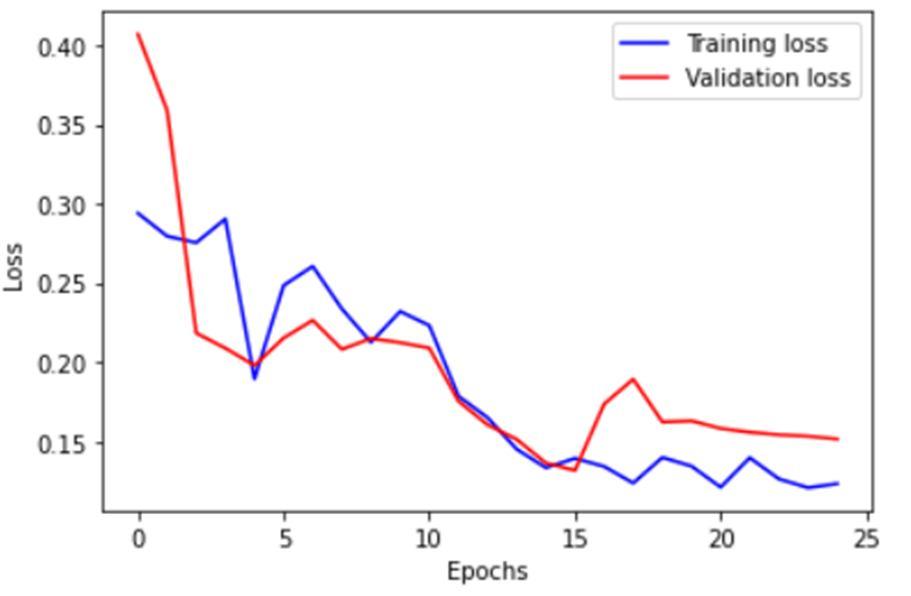


The accuracy and validation curves of the all models with epochs is shown in fig7,8,9
Fig. 7 Graph of metrics of CNN Model
Fig. 8 Graph of metrics of MobileNetV2 Model
Fig. 9 Graph of metrics of Inception V3 Model
Our model is evaluated using metrics, which tell about progress and evaluate the model. Classification metrics evaluate a model and make a report of performance, but each metrics evaluate in a different way. Various metrics available such as Accuracy, f1 score, Precision and Recall. The Classification Report containing all metrics of few models shown in fig 10,11,12.

ISSN: 2321 9653; IC Value: 45.98; SJ Impact Factor: 7.538 Volume 10 Issue XI Nov 2022 Available at www.ijraset.com

Fig. 10 Classification Metrics of CNN Model


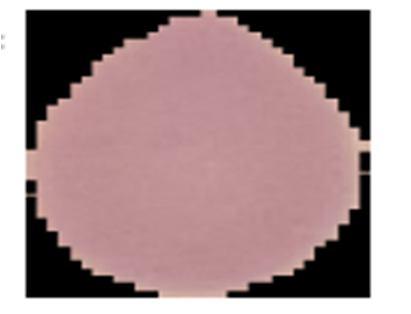

Fig. 11 Classification Metrics of Inception V3 Model
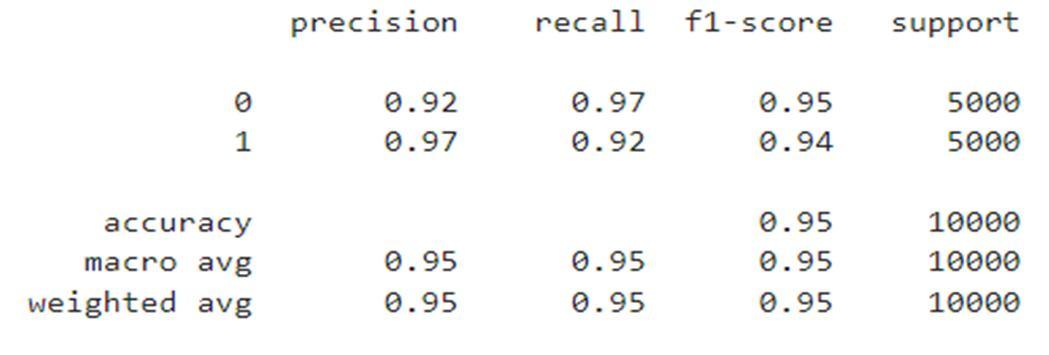
Fig. 12 Classification Metrics of MobileNetV2 Model

Fig. 13 Prediction Output
Deep learning has been increasingly improving the field of healthcare and accounts for a wide prospect of applications. Apart from using traditional learning, deep learning is a breakthrough in machine learning, which can learn on its own through complex features from input data without the need to use feature engineering. Malaria detection challenge, traditional methods requires more time and medical experts of analyzing cell images manually. So this study aimed at creating a model which is useful in detecting parasites in the cell image. The proposed model in this study, transfer learning models MobileNetv2 and inceptionv3 provides accuracy of 96% while detecting cell images while the CNN model also provided 95% accuracy. Key to this effort, this study gives a relative study of how pre trained model representations learned by previous layers useful to extract features on other studies in similar field. These models can be put to various studies of more diseases.
ISSN: 2321 9653; IC Value: 45.98; SJ Impact Factor: 7.538 Volume 10 Issue XI Nov 2022 Available at www.ijraset.com
[1] WHO. World malaria report 2021. World Health Organization; 2021
[2] Amogh Manoj Joshi, Ananta Kumar Das, & Subhasish Dhal. (December 2020). “Deep Learning Based Approach For Malaria detection in Blood Cell Images” 2020 IEEE REGION 10 CONFERENCE (TENCON). IEEE.
[3] Kamble, R. A., E, S., Sajjan, S., Shetty , T., & Patil, D.(2022). “MALARIA DISEASE DETECTION USING DEEP LEARNING” International Research Journal of Modernization in Engineering Technology and Science


[4] Singh, A., Porwal, N., & Kumar, A. (2021). “Malaria Detection using Deep learning” Turkish Journal of Computer and Mathematics Education Vol.12 No 13
[5] Sarkar, S., Sharma, R., & Shah, K. (Oct 2020). “Malaria detection from RBC images using shallow Convolutional Neural Networks” arXiv:2010.11521 [eess.IV].
[6] Reddy, A., & Juliet, D. (April 4 6, 2019,). “Transfer Learning with ResNet 50 for Malaria Cell Image Classification” International Conference on Communication and Signal Processing.
[7] Maqsood A.; Farid M.S., Khan, M.H, Grzegorzek.M “Deep Malaria Parasite Detection in Thin Blood Smear Microscopic Images”. Appl. Sci. 2021, 11, 2284 https:// doi.org/10.3390/app11052284
[8] Abubakar, A.; Ajuji, M.; Yahya, I.U. DeepFMD: “Computational Analysis for Malaria Detection in Blood Smear Images Using Deep Learning Features” Appl. Syst. Innov. 2021, 4, 82. https:// doi.org/10.3390/asi4040.
[9] Nayak, S., Kumar, S., & Jangid, M. (2019). “Malaria Detection Using Multiple Deep Learning Approaches” 2019 2nd International Conference on Intelligent Communication and Computational Techniques (ICCT)
[10] J. SOMASEKAR, A. SHARMA, N. M. REDDY, AND Y.C.A. PADMANABHA REDDY. “IMAGE ANALYSIS FOR AUTOMATIC ENUMERATION OF RBC INFECTED WITH PLASMODIUM PARASITES IMPLICATIONS FOR MALARIA DIAGNOSIS”. Advances in Mathematics: Scientific Journal 9 (2020), no.3, 1229 1237
